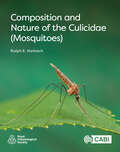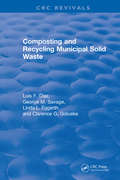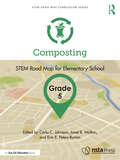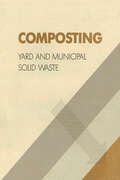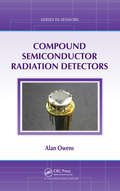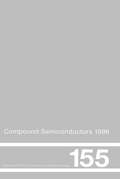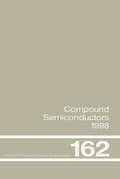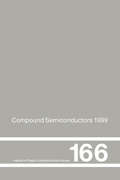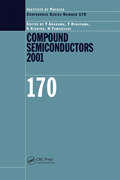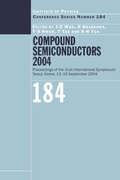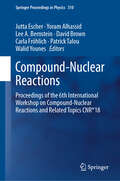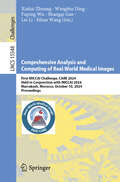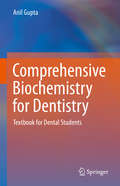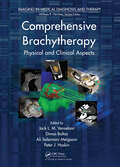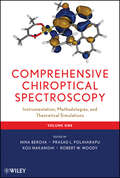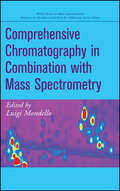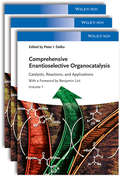- Table View
- List View
Composition and Nature of the Culicidae (Mosquitoes)
by Ralph HarbachThis landmark volume is a unique, comprehensive compendium of all the biosystematics information on mosquitoes available today. Its purpose is to provide the international community with an up-to-date authoritative resource on the taxonomy and systematics of the entire family of this crucially important group of insects. The book exhaustively summarizes the large and varied taxonomic literature on mosquitoes, providing a useful and practical amalgamation of their nomenclatural history, classification, morphology, bionomics and evolution. The need for this volume coincides with the growing paucity of professional traditional taxonomists who are still available to assist and advise the new generation of molecular biologists in the principles and practice of zoological nomenclature, morphotaxonomy and classification. For this reason, the compilation is an invaluable resource for students, researchers, entomologists, librarians and anyone interested in the taxa that comprise the family Culicidae. It is no exaggeration to state that this book is a monumental piece of work. It treats and provides detailed information for all formal and informal elements of hierarchical classification, from species to family level. All parts of the book are interlinked and provide a platform of data for others to use and build upon.
Compost Utilization in Production of Horticultural Crops
by Dr Monica Ozores-HamptonCompost Utilization in Production of Horticultural Crops provides information for the compost industry to develop horticulture production efforts and techniques. This highly practical book contains information applicable to current production issues facing the fruit and nuts, vegetable, and ornamentals and turfgrass industry. Written by scientific experts, chapters evaluate the uses of compost for greater crop yields and decreased plant disease and pesticide application, irrigation water and fertilizer demand. Considering compost use increases carbon sequestration, the book provides guidelines on converting safe waste materials into composted soil amendments while minimizing negative impacts on the environment. Chapters cover the diversity and variability on compost uses of available feedstocks; composting methods, application rates, methods and timing; and considers the benefits of application alone or combined with other organic or inorganic nutrient sources. Practical reference for regular use by professionals in compost and horticulture industries. Presents information for both agricultural and waste management. Addresses the effects of compost on soil health and food safety. Discusses compost quality and compost as a supplement in soil fertility programs. Features information on compost nematodes management, compost teas effect on foliar diseases, and the economic impact of compost on crop production. This book is essentail reading for fruit and nuts, vegetable, ornamental, landscape and turfgrass producers; waste and compost industry representatives, consultants and regulators; and academic plant and soil science researchers.
Composting and Recycling Municipal Solid Waste (CRC Press Revivals)
by Luis F. Diaz Clarence G. Golueke George M. Savage Linda L. EggerthComposting and Recycling Municipal Solid Waste is a comprehensive guide that identifies, describes, explains, and evaluates the options available when composting and recycling municipal solid waste (MSW). The book begins with an introductory chapter on the nature of MSW and the importance of solid waste management programs and resource recovery. Chapter 2 discusses MSW storage and collection, with emphasis on recyclables. Chapter 3 examines issues involved in determining the quantity, composition, and key physical characteristics of the MSW to be managed and processed. The book's other chapters cover topics such as the steps required for processing MSW for material recovery, the use of uncomposted organic matter as a soil amendment, composting and use of compost product, the marketing of recyclables, biogasification, and integrated waste management. Composting and Recycling Municipal Solid Waste provides essential information needed by solid waste professionals, consultants, regulators, and planners to arrive at rational decisions regarding available economic and technological resources for MSW composting and recycling.
Composting, Grade 5: STEM Road Map for Elementary School (STEM Road Map Curriculum Series)
by Carla C. Johnson Erin E. Peters-Burton Janet B. WaltonWhat if you could challenge your fifth-grade students to investigate the role of composting in solid waste management? With this volume in the STEM Road Map Curriculum Series, you can! Composting outlines a journey that will steer your students toward authentic problem solving while grounding them in integrated STEM disciplines. Like the other volumes in the series, this book is designed to meet the growing need to infuse real-world learning into K–12 classrooms. This interdisciplinary, four-lesson module uses project- and problem-based learning to help students use the engineering design process (EDP) to design and create prototypes of compost systems and build a full-scale composting system for school use. Students will synthesize their learning about biotic and abiotic factors, decomposition, and engineering design as they learn about various types of compost systems, create their own portable compost bins, and create materials for a composting publicity campaign at their school. To support this goal, students will do the following: Identify and explain interdependent relationships in ecosystems Compare and contrast several ecosystems Describe how compost systems are designed and constructed and apply this understanding to creating prototypes of various compost systems Understand the concept of scale and apply this understanding to create scaled models of compost systems Apply their understanding of composting, compost systems, and the EDP to create a full-scale compost system for the school Measure various characteristics of compost The STEM Road Map Curriculum Series is anchored in the Next Generation Science Standards, the Common Core State Standards, and the Framework for 21st Century Learning. In-depth and flexible, Composting can be used as a whole unit or in part to meet the needs of districts, schools, and teachers who are charting a course toward an integrated STEM approach.
Composting, Grade 5: STEM Road Map for Elementary School (STEM Road Map Curriculum Series)
by Carla C. Johnson Erin E. Peters-Burton Janet B. WaltonWhat if you could challenge your fifth-grade students to investigate the role of composting in solid waste management? With this volume in the STEM Road Map Curriculum Series, you can! Composting outlines a journey that will steer your students toward authentic problem solving while grounding them in integrated STEM disciplines. Like the other volumes in the series, this book is designed to meet the growing need to infuse real-world learning into K–12 classrooms.This interdisciplinary, four-lesson module uses project- and problem-based learning to help students use the engineering design process (EDP) to design and create prototypes of compost systems and build a full-scale composting system for school use. Students will synthesize their learning about biotic and abiotic factors, decomposition, and engineering design as they learn about various types of compost systems, create their own portable compost bins, and create materials for a composting publicity campaign at their school.To support this goal, students will do the following: Identify and explain interdependent relationships in ecosystems Compare and contrast several ecosystems Describe how compost systems are designed and constructed and apply this understanding to creating prototypes of various compost systems Understand the concept of scale and apply this understanding to create scaled models of compost systems Apply their understanding of composting, compost systems, and the EDP to create a full-scale compost system for the school Measure various characteristics of compost The STEM Road Map Curriculum Series is anchored in the Next Generation Science Standards, the Common Core State Standards, and the Framework for 21st Century Learning. In-depth and flexible, Composting can be used as a whole unit or in part to meet the needs of districts, schools, and teachers who are charting a course toward an integrated STEM approach.
Composting: Yard and Municipal Solid Waste
by United States Environmental Protection AgencyThis book aims to aid decision-makers in planning, siting, designing, and operating composting facilities. It is also useful to citizens, regulators, consultants, and vendors interested in the composting of yard trimmings and municipal solid waste.
Compound Semiconductor Radiation Detectors (ISSN)
by Alan OwensAlthough elemental semiconductors such as silicon and germanium are standard for energy dispersive spectroscopy in the laboratory, their use for an increasing range of applications is becoming marginalized by their physical limitations, namely the need for ancillary cooling, their modest stopping powers, and radiation intolerance. Compound semicond
Compound Semiconductors 1995, Proceedings of the Twenty-Second INT Symposium on Compound Semiconductors held in Cheju Island, Korea, 28 August-2 September, 1995
by WooCompound Semiconductors 1995 focuses on emerging applications for GaAs and other compound semiconductors, such as InP, GaN, GaSb, ZnSe, and SiC, in the electronics and optoelectronics industries. The book presents the research and development work in all aspects of compound semiconductors. It reflects the maturity of GaAs as a semiconductor material and the rapidly increasing pool of research information on many other compound semiconductors. Covering the full breadth of the subject, from growth through processing to devices and integrated circuits, this volume provides researchers in materials science, device physics, condensed matter physics, and electrical and electronic engineering with a comprehensive overview of developments in this well-established research area.
Compound Semiconductors 1996, Proceedings of the Twenty-Third INT Symposium on Compound Semiconductors held in St Petersburg, Russia, 23-27 September 1996
by M.S. ShurProviding a comprehensive overview of developments to both the academic and industrial communities, Compound Semiconductors 1996 covers all types of compound semiconducting materials and devices. The book includes results on blue and green lasers, heterostructure devices, nanoelectronics, and novel wide band gap semiconductors. With invited review papers and research results in current topics of interest, this volume is part of a well-known series of conferences for the dissemination of research results in the field.
Compound Semiconductors 1998: Proceedings of the Twenty-Fifth International Symposium on Compound Semiconductors held in Nara, Japan, 12-16 October 1998
by H Sakaki; J-C Woo; N Yokoyama; Y HirayamaCompound Semiconductors 1998 explores research and development in key semiconductor materials and III-V compounds such as gallium arsenide, indium phosphide, gallium nitride, silicon germanium, and silicon carbide. It critically assesses progress in key technologies such as reliability assessment and reports on advances in the use of semiconductors in modern electronic and optoelectronic devices. Coverage in this volume reflects the increased interest and research funding in nitride-based materials; wide band-gap devices; mobile communications, including III-V-based transistors and photonic devices; crystal growth and characterization; and nanoscale phenomena, such as quantum wires, dots, and other low dimensional structures.
Compound Semiconductors 1999: Proceedings of the 26th International Symposium on Compound Semiconductors, 23-26th August 1999, Berlin, Germany (ISSN)
by K H Ploog G Tränkle G WeimannThis reference presents an overview of important developments in all III-V compound semiconductors such as GaAs, InP, and GaN; II-VI compounds such as ZnS, ZnSe, and CdTe; IV-IV compounds such as SiC and SiGe; and IV-VI compounds such as PbTe and SnTe. It emphasizes piezoelectric (or potentially smart) material heterostructures (Ga, Al, In)N, which will influence future research and development funding. As the preeminent forum for research in compound materials and their applications in devices, this book provide[s] a very useful review of developments in this field and will be necessary reading for most researchers in electronics (Aslib Book Guide).
Compound Semiconductors 2001 (Institute of Physics Conference Series)
by Hiroshi Yamaguchi Yoshiro Hirayama Yasuhiko Arakawa Katsumi KishinoAn international perspective on recent research, Compound Semiconductors 2001 provides an overview of important developments in III-V compound semiconductors, such as GaAs, InP, and GaN; II-VI compounds, such as ZnSe and CdTe; and IV-IV compounds, such as SiC and SiGe. The book contains 139 papers arranged in chapters on electronic devices, optical
Compound Semiconductors 2004: Compound Semiconductors for Quantum Science and Nanostructures (Institute of Physics Conference Series)
by Takafumi Yao Jong-Chun Woo Hideki Hasegawa Young-Se Kwon Keon-Ho YooCompound Semiconductors 2004 was the 31st Symposium in this distinguished international series, held at Hoam Convention Center of Seoul National University, Seoul, Korea from September 12 to September 16, 2004. It attracted over 180 submissions from leading scientists in academic and industrial research institutions, and remains a major forum for t
Compound-Nuclear Reactions: Proceedings of the 6th International Workshop on Compound-Nuclear Reactions and Related Topics CNR*18 (Springer Proceedings in Physics #254)
by David Brown Walid Younes Jutta Escher Yoram Alhassid Lee A. Bernstein Carla Fröhlich Patrick TalouThe Compound-Nuclear Reaction and Related Topics (CNR*) international workshop series was initiated in 2007 with a meeting near Yosemite National Park. It has since been held in Bordeaux (2009), Prague (2011), Sao Paulo (2013), Tokyo (2015), and Berkeley, California (2018). The workshop series brings together experts in nuclear theory, experiment, data evaluations, and applications, and fosters interactions among these groups. Topics of interest include: nuclear reaction mechanisms, optical model, direct reactions and the compound nucleus, pre-equilibrium reactions, fusion and fission, cross section measurements (direct and indirect methods), Hauser-Feshbach theory (limits and extensions), compound-nuclear decays, particle and gamma emission, level densities, strength functions, nuclear structure for compound-nuclear reactions, nuclear energy, nuclear astrophysics, and other topics. This peer-reviewed proceedings volume presents papers and poster summaries from the 6th International Workshop on Compound-Nuclear Reactions and Related Topics CNR*18, held on September 24-28, 2018, at Lawrence Berkeley National Lab, Berkeley, CA.
Comprehensive Analysis and Computing of Real-World Medical Images: First MICCAI Challenge, CARE 2024, Held in Conjunction with MICCAI 2024, Marrakesh, Morocco, October 10, 2024, Proceedings (Lecture Notes in Computer Science #15548)
by Xiahai Zhuang Lei Li Sihan Wang Fuping Wu Wangbin Ding Shangqi GaoThis book constitutes the proceedings of the First MICCAI Challenge, CARE 2024, Held in Conjunction with MICCAI 2024, in Marrakesh, Morocco, during October 2024. The 23 full papers together included in this volume were carefully reviewed and selected from numerous submissions. Five tracks have been held in this challenge, including one comprehensive issue and four specific tracks with corresponding images and clinical problems: 1. Transferring Foundation Models for Multi-center Real-World Medical Image Analysis (TFM4MedIA) 2. Left Atrial and Scar Quantification & Segmentation (LAScarQS++) 3. Liver Fibrosis Quantification and Analysis (LiQA) 4. Myocardial Pathology Segmentation (MyoPS++) <p class="MsoListParagraphCxSpLast" style="margin-bottom: 0cm; mso-add-space: auto; text-indent: -18.0pt; line-height: normal; mso-list: l0
Comprehensive Biochemistry for Dentistry: Textbook for Dental Students
by Anil GuptaThis book combines fundamental concepts of biochemistry and the dental sciences to provide an authentic, coherent and comprehensive text for dental students. It describes in simple language the intricate pathophysiology of biomolecules in health and in diseases of dental and oral tissues. This book also describes the evolution of biochemistry in a chronological order, provides information about the fundamental chemical structure, classification and biological significance of biomolecules, vitamins and hormones, enriched with flow charts and diagrams for easy understanding and quick reference. It includes chapters on nucleic acids, nutrition and serum enzymes and organ function tests, and offers an innovative approach to familiarize dental students with the biochemical composition of enamel, dentine, cementum and saliva, explaining the biochemical basis of dental caries, periodontal diseases, role of fluorides in caries prophylaxis, fluoride toxicity, and the role of amino acids as anti-hypersensitive agents.
Comprehensive Brachytherapy: Physical and Clinical Aspects (Imaging in Medical Diagnosis and Therapy)
by Peter J. Hoskin Jack L. M. Venselaar Dimos Baltas Ali S. MeigooniModern brachytherapy is one of the most important oncological treatment modalities requiring an integrated approach that utilizes new technologies, advanced clinical imaging facilities, and a thorough understanding of the radiobiological effects on different tissues, the principles of physics, dosimetry techniques and protocols, and clinical expertise. A complete overview of the field, Comprehensive Brachytherapy: Physical and Clinical Aspects is a landmark publication, presenting a detailed account of the underlying physics, design, and implementation of the techniques, along with practical guidance for practitioners.Bridging the gap between research and application, this single source brings together the technological basis, radiation dosimetry, quality assurance, and fundamentals of brachytherapy. In addition, it presents discussion of the most recent clinical practice in brachytherapy including prostate, gynecology, breast, and other clinical treatment sites. Along with exploring new clinical protocols, it discusses major advances in imaging, robotics, dosimetry, Monte Carlo-based dose calculation, and optimization.
Comprehensive Chiroptical Spectroscopy, Applications in Stereochemical Analysis of Synthetic Compounds, Natural Products, and Biomolecules
by Nina Berova Prasad L. Polavarapu Robert W. Woody Koji NakanishiThis book provides an introduction to the important methods of chiroptical spectroscopy in general, and circular dichroism (CD) in particular, which are increasingly important in all areas of chemistry, biochemistry, and structural biology. The book can be used as a text for undergraduate and graduate students and as a reference for researchers in academia and industry. Experimental methods and instrumentation are described with topics ranging from the most widely used methods (electronic and vibrational CD) to frontier areas such as nonlinear spectroscopy and photoelectron CD, as well as the theory of chiroptical methods and techniques for simulating chiroptical properties. Applications of chiroptical spectroscopy to problems in organic stereochemistry, inorganic stereochemistry, and biochemistry and structural biology are also discussed, and each chapter is written by one or more leading authorities with extensive experience in the field.
Comprehensive Chiroptical Spectroscopy, Instrumentation, Methodologies, and Theoretical Simulations
by Nina Berova Prasad L. Polavarapu Robert W. Woody Koji NakanishiThis book provides an introduction to the important methods of chiroptical spectroscopy in general, and circular dichroism (CD) in particular, which are increasingly important in all areas of chemistry, biochemistry, and structural biology. The book can be used as a text for undergraduate and graduate students and as a reference for researchers in academia and industry, with or without the companion volume in this set. Experimental methods and instrumentation are described with topics ranging from the most widely used methods (electronic and vibrational CD) to frontier areas such as nonlinear spectroscopy and photoelectron CD, as well as the theory of chiroptical methods and techniques for simulating chiroptical properties. Each chapter is written by one or more leading authorities with extensive experience in the field.
Comprehensive Chromatography in Combination with Mass Spectrometry
by Luigi MondelloThis book provides a detailed description of various multidimensional chromatographic separation techniques. The editor first provides an introduction to the area and then dives right into the various complex separation techniques. While still not used routinely comprehensive chromatography techniques will help acquaint the readers with the fundamentals and possible benefits of multi-dimensional separations coupled with mass spectrometry.The topics include a wide range of material that will appease all interested in either entering the field of multidimensional chromatography and those looking to gain a better understanding of the topic.
Comprehensive Enantioselective Organocatalysis
by Peter I. DalkoA much-needed overview reflecting the developments over the past five years, this is the most comprehensive handbook on organocatalysis. As such, all relevant catalyst systems are discussed in detail, as well as key strategies, reaction types, and important applications in total synthesis. The first two volumes cover catalyst structures and fundamental activation types. These chapters allow readers to familiarize themselves with the relatively complex interactions that make organocatalytic reactions selective; to gain an insight into the most efficient catalyst types; and to understand the importance of physical parameters that influence reactivity and selectivity. Volume three is structured around reaction types, i.e. nucleophile additions to C=X and C=C bonds; Friedel-Crafts reactions, organocatalytic sigmatropic reactions, regioselective reactions and desymmetrization strategies, ring-forming reactions, multicomponent (domino) reactions, multicatalyst systems and the application of organocatalytic reactions in multistep synthesis are discussed. An appendix recollecting catalyst structures with the adequate cross-references to the corresponding chapters rounds off the book.With its contributions written by pioneers of the organocatalysis field, this book provides non-specialists with an introduction to the topic as well as serving as a valuable source for researchers in academia and industry searching for an up-to-date and comprehensive overview of this promising area of synthetic organic chemistry.
Comprehensive Guide to Hallucinogenic Plants (Exploring Medicinal Plants)
by Noureddine Chaachouay Abdelhamid Azeroual Lahcen ZidaneHallucinogens have been traditionally used to encourage spiritual growth, heighten perception, inspire personal development, or expand reality. Comprehensive Guide to Hallucinogenic Plants focuses on ethnobotanical aspects of hallucinogenic plant species, featuring history on how they were used in ancient societies, identifying chemical compounds, and explaining modern medicinal uses, as well as conservation initiatives. The book emphasizes the importance of understanding the cultural, countrywide, environmental, and scientific importance of these medicinal plants.Some of the 50 plants covered in this work include: ayahuasca, ginger, kanna, dream herb, iboga, peyote, canary broom, coral tree, catnip, wild rue, kava, mandrake, and golden angel's trumpet. Each chapter includes information on historical plant use and identification of chemical compounds, and explains modern medicinal uses. The text highlights the importance of studying, evaluating, and utilizing these plants not in isolation, but from a global perspective.Comprehensive Guide to Hallucinogenic Plants appeals to plant scientists, botanists, ethnobotanists, pharmacologists, and those with an interest in alternative or herbal medicine.
Comprehensive Handbook of Chemical Bond Energies
by Yu-Ran LuoUnderstanding the energy it takes to build or break chemical bonds is essential for scientists and engineers in a wide range of innovative fields, including catalysis, nanomaterials, bioengineering, environmental chemistry, and space science. Reflecting the frequent additions and updates of bond dissociation energy (BDE) data throughout the literat
Comprehensive Home Science class 10 - CBSE Board
by Anju ChauhanThe book "Comprehensive Home Science - Class X" by Anju Chauhan serves as an essential academic guide aligned with the CBSE syllabus. It is structured to holistically cover both theoretical and practical aspects of Home Science, ensuring a balanced learning experience. The book is divided into six units focusing on various topics like human growth and development, resource management, food safety, personal hygiene, meal planning, and textile care. Each chapter is enriched with diagrams, tables, and summaries to enhance understanding and retention. Practical exercises, thought-provoking questions, and MCQs help students prepare effectively for examinations. Key highlights include emphasis on conceptual clarity, integration of real-life applications, and alignment with NEP 2020 goals, such as fostering life skills, critical thinking, and ethical values. It addresses challenges in education by adopting a student-centered approach that balances academic rigor with flexibility in learning styles. The book not only aids in board exam preparation but also instills a foundation for practical knowledge in daily life management.
Comprehensive Home Science class 9 - CBSE Board
by Ms PoonamThe book Comprehensive Home Science for Class IX by Ms. Poonam serves as an educational resource aligned with the CBSE syllabus, introducing students to the foundational concepts and practical aspects of Home Science. It encompasses diverse topics such as the meaning and importance of Home Science, family dynamics, nutrition and health, cooking methods, safety at home, textiles and clothing, and the selection of fabrics and attire. Structured in eight units, it combines theoretical knowledge with practical applications, emphasizing real-life skills and scientific approaches for harmonious family and community living. Rich with illustrations, tables, and pointwise summaries, the book is designed for ease of understanding and quick learning, catering to both boys and girls to encourage balanced skill development and career opportunities in the field.
